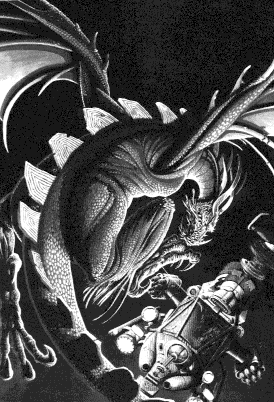3D map
the life of dragon

A dragon's life is a very long one compared to humans. On the average, dragons live 1,200 human years.
A dragon's life is not boring by any means. They live to learn, and to gather knowledge, as well as a huge hoard
of treasure. Gathering knowledge of every type, from how a sword gets forged, to how insects help the environment,
is a high priority in a dragons life, and does take up a good part of a dragon's day.
KNOWLEDGE & HOARDS
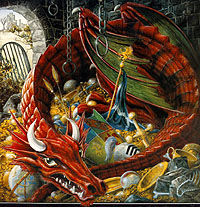
If a person has knowledge the dragon does not have, after it learns it (willingly given from the person), it will give that person a token of gratitude such as a trinket from its own treasure. Gathering treasure is a favorite past-time of Western dragons. Dragons begin at a young age, when they get their own cavernous home, to start their own hoard. All dragons love beautiful things. Western dragons are fickle, and only gather the most beautiful goldsmith work, such as crowns, the best cut jewels, and well minted coins. Some theories say that a dragon's hoard is a symbol of rank in dragon-society, but other theories say that the dragons just like the look and feel of the coins and other sundry items. Some dragons inherit previous treasures from their parents, but most of the time dragons will gather items here and there from around the world, and bring them home. Some dragons are very well organized and will go so far as to separate gold, silver, jewels, etc. in separate piles. To find a dragon abode and steal some treasure is a quest for some thieves and rogues to be ranked in their guilds.
THE MATING FLIGHT
Dragons usually lead a solitary life until they meet their life-long mate during their mating flight ritual. A female will mate only 1 to 4 times in her life. It is a grand site to see. When a female dragon is ready to mate. She will sound a resonating "mating-call" to all the mature males around the area. She will then fly as fast, and as high as she possibly can. The female can easily out-fly any male, due to her weight, and wingspan. Only the strongest and fastest of the males will catch her. When a male dragon finally catches the female at the climax of their flight, they will literally hang for a second in mid-air with the male wrapping his tail and wings tightly around the female's, and grasp her with all four claws. The female will follow suit as they begin a free-fall which is the mating session. Falling fast, the mating only lasts a few seconds, and both dragons will break off just before crashing into the ground, and glide together to the female dragon's cave to prepare their nest.
NEST BUILDING
The nest building begins the same day as the mating takes place. Both the male and female dragon add to building their nest. The nest materials can consist of woven tree branches, and fresh leaves intertwined with gold and jewels. The floor of the net consists of flat coins that are melted into a bowl by the dragons breathing fire and melting them into the woven branches. Dragons apparently like a very beautiful nesting area. The nest will be built upon part of the two dragon's combined treasures. It is theorized when the dragons sit upon the nest, the body heat will warm the gold and keep the nest warm even when the dragon is not directly on the eggs. Building the nest will be slow, it takes roughly a year and a half, human years to build it.
LAYING OF THE EGGS
After 2 years of gestation, a female will lay several (1-6) ovoid leathery-hard eggs, called a clutch. The ratio of male to female hatchlings is 3 to 1. During the nesting, the male and female will take turns either finding food, and keeping the eggs warm. The dragon hunting will bring an elk, or some other large animal back for both to share in the cave. After both have their fill, the carcass is tossed over the edge of the mountain where the various animals near the lair will get their meal. A tell-tale sign that a dragon-cave is nearvis the fact that there are a large number of bones near a mountain.
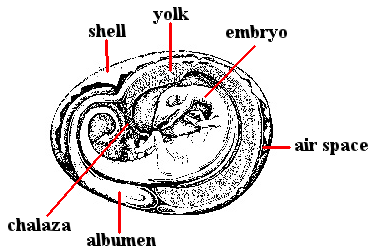 THE HATCHING
THE HATCHINGAfter 2 months of nesting, the baby dragons emerge from their eggs. Each baby dragon has an egg-tooth, which is a sharp, pointed bone at the front of their snout. This is used to break out of the shell. When the first dragon starts to emerge and cry, it urges the other baby dragons to hatch. Dragon's hatch ferociously hungry, and if are not fed immediately after hatching, they will eat the yolk and albumen (white part of an egg). If not fed immediately after this they will go after their siblings. It is very important for the parents to know when the dragons are ready to hatch so they can have fresh meat to satisfy their sons and daughters. This first feeding bonds the newly hatched dragons to their parents. After the hatching, both adult dragons fiercely guard their hatchlings. One dragon will always be awake to keep watch over the nest, until the newly hatched dragons can defend themselves.
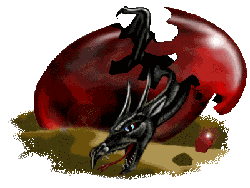 THE WYRMLING
THE WYRMLINGA baby dragon when born, weighs 80-odd pounds and its about 6 feet in length. The wyrmling is born able to see, and hear. They also have a full set of razor sharp baby teeth. Their wings are too small and weak to fly. The tiny scales covering their body are very soft when first hatching, but will harden within a year. Some species of dragon are born with an innate ability (some say magic) such as to become invisible at will. The dragon is considered a wyrmling from hatching until age 15.
THE GROWING PERIOD
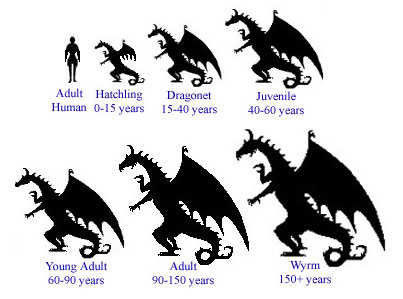
At age 40, the dragon is considered a juvenile. At this age, the juvenile dragon will test its flying abilities, and will make its first flight. The mother and father dragon will teach the dragons on how to take off from a cliff, how to use the thermals, and how to land. There is some natural instincts that the dragons have when first learning to fly, such as how often to flap the wings to stay in the air. The juvenile dragon will revel in the act of flying, and will be in the air most of the time during the next few years to keep gaining wing length and strength in the flight muscles.
At age 60, the dragon is now considered an Young Adult. He has learned all the aspects of flying, including how to take off from flat land which is most difficult for a young dragon, due to the immense force needed to do so. Around age 65 the dragons leave their hatching grounds to find their own caves to take as their own. They prefer to own places that are on sheer cliff faces, with a large enterance, and large living area, with smaller caves and tunnels weaving in and out of the cliff-face.
At age 90, the dragon is almost fully grown and is considered an Adult Dragon. The dragon will search miles around its own territory, and learn every nook and cranny about the area. The adult dragon will mark its territory by secreting a substance, and spitting it on rocks, and trees clearly defining his circular area around his cave. All dragons have an incredible sense of smell and this secretion is a beacon that another dragon is near. During this time, adult dragons will search out an elder dragon to learn magic. An Elder will teach the adult dragon the ways of the past through magic and knowledge.
Around age 100, the dragons will have a hormonal change within their bodies and will get urges to mate. Females will change to a brighter shade of their regular color during the mating season due to this change. The males will notice this change and get riled up so much as to fight with other males that are ready to mate as well. These fights are never fatal, but sometimes do cause some serious damage to the males, especially the wing membrane, which is the most vulnerable part of a dragon's body. The fights usually consist of dragons diving towards each other and butting heads, and swiping with claws on the tough scales of the chest. When the male dragons hear the females mating call, the dragons at once take to the skies to find her, and the chase is on!
At age 150, the dragon is now a Wyrm. This age is a continuing cycle of learning knowledge, learning magic, and raising a few more clutches of young. And of course, hoarding as much treasure as they can find to fill their caves. The pair of dragons will live together for the rest of their lives together even after all matings have finished.
THE GREAT WYRMS
If a dragon lives past the age of 900 years, they are considered a Great Wyrm, and an Elder of the dragon community. All dragons will hold a great meeting to admit the new Great Wyrm to the society of dragons. Great Wyrms are highly regarded for their knowledge, their magical ability, and their prime wisdom. Elders are responsible for the teaching of past history of dragon kind, history of the world, and magic to the adult dragons. If there is an emergency that includes the dragon community, the Elders will call a grand-meeting to discuss the problem and what to do about it. These are the only two times in a dragon's life that they will see so many of their kind in one area.
END OF THE LIFE-CYCLE
A dragon rarely lives past 1,500. When the time comes, the dragon realizes his life-cycle has come to an end. He will gather all Great Wyrms at the rim of a great volcano. All the Great Wyrms will howl a great song named "The Passing Song". This song will continue for a full half hour, and can be heard for 300 miles around. This announces the passing of an Elder. Once the song is heard by Adult Dragons, they will howl the same song for all to hear until all dragons on a world will understand they have lost a great member of their community. During the song, the dying Great Wyrm will circle the live volcano and then dive straight down into the lava to give himself back to the earth that spawned him.
physiology of dragon
Friday, November 20, 2009

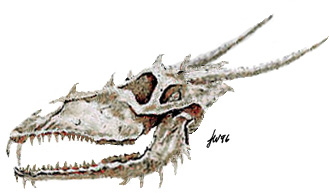
Ever wonder what a dragon looked like from the inside out?
THE SKELETON
The Western dragon Eudraco magnificus occidentalis has a sturdy skeleton structure. Large head, long neck, broad shoulders, thick legs, strong tail, and very large wings. The dragon's bones are very strong, but hollow and light. A dragon's jaw is large to accommodate the very strong muscles around it. The dragon is able to dislocate its jaw, as some snakes are able to do, to grab large objects. The dragon has two types of teeth because of it being an omnivore (It will eat meat and plant food). The canine and incisor teeth of a dragon are long and razor sharp, but also have molars to chew their food instead of eating it whole. The shoulder bones are thick to handle the large wing muscles needed to fly. The wing "finger" bones are very long to wrap the thin flight membrane taut around them. There are many species of Western dragon, and this is only one example showing the different bones of the skeletal system.
Take a look at the Western Dragon Skeleton System by clicking on the picture below! (size=258K)
The Oriental (or Eastern) dragon Dracoserpens Lung orientalis has a extremely long, thin skeleton structure. It has a medium sized head, very long neck, short legs, small hips, and a long tail. This skeleton is very maneuverable because of the shape, such as a long snake is. It can twist and turn its body in all sorts of ways. This type of dragon does not have hollow bones, and the dragon's skeleton is thin because it doesn't need the mass to accommodate flight muscles. This dragon does not have any type of wings as it flies with earth-magic verses brute strength.
Take a look at the Eastern Dragon Skeleton System by clicking on the picture below! (size=32K)
MUSCLES
Western dragons have many more muscles then their Eastern cousins. This is mainly due to their massive flight muscles that have to lift their weight into the sky with the thrust of their wings. The main wing muscles are the Supraspinatus and Flexor alae major. Notice that the actual wing does not have many major muscles, it is all near the chest area. Other large muscles account for a very strong tail, and rear legs. The Western dragon could easily hold a human male's weight while in flight. Also notice the large jaw muscle Masseter, this muscle can easily crush bones.
Take a look at the Western Dragon Musculature System by clicking on the picture below! (size=262K)
OUTSIDE OF THE BODY
The dragon can be a huge creature depending on the breed. The one shown here is roughly 20 feet long with a wingspan of 35 feet. This type of dragon has extremely small ears, large eyes, spines down its back, and a bone-type spade at the end of its tail. All dragon breeds are different. Some have long ears, and no spade, and some have a fleshy-type triangle-shaped spade. This type of dragon also does not have scales, it has tough leathery skin. Most dragons have scales of some sort.
Take a look at the Western Dragon Body by clicking on the picture below! (size=256K)
SCALES
Scales (and horns/claws) on a dragon are densely packed cells made up of keratin, a tough fibrous protein. When born, a dragon's scales are as soft as tissue paper, and slowly harden while the dragon grows. The iron from the blood, or vegetable matter the dragon eats is absorbed by the dragon's blood stream and mixed with the keratin to create steel-hard scales. The process of getting scales as tough as they can get takes about one year after being hatched.
COLOR
Scale color is determand by the genes of the parent dragons. Usually only red dragons will mate with other red dragons, etc. But if a mating took place between a gold and a green dragon, the result might be a bronze colored offspring. Scales on a dragon are never simply one shade of color. If a dragon is blue, there will be many, many shades of blue. Light, medium, dark, blue-black, etc. Scales are bright and shiny in a healthy dragon, but dull and muted if a dragon is ill.

CAMOUFLAGE
In some breeds of dragons when the dragon is mature, the cells in the scales are able to change color such as a chameleon due to chromatophore, the pigment cells in the scales.This reaction can be caused by emotion (anger, happiness,etc) or by the will of the dragon to change color. If the dragon is angered it can change from its original color to a bright, fierce color such as red, to look more intimidating or during mating rituals, it can flow certain color patterns on its body to attract other dragons. Since dragons are extremely intelligent, it can choose which colors to change into to match the exact background it is near including subtle shadow and highlights. It is so good at this, most things would just walk past a 65 foot dragon hiding in the sand.
A DRAGON'S ARMOR
The main function of scales is protection of the soft skin tissue of the dragon. An adult dragon can easily take a direct blow from a knight's sword and hardly flinch. Adult dragons have 4-6 inch wide, and 7-9 inch long teardrop shaped scales covering its body. The pattern of the body scales is a flat, rotating design that overlap each other. Easy movement is due to the unique depression on the top side of each scale that allows them to lay evenly flat on the body.
The scales on the chest area are the largest; easily being over a foot wide. The chest scales are one to three flat "scale flaps". These are shaped differently than a regular scale as they are more squarish. The pattern of the chest scales is overlapping and flat running from the throat, under body to the end of the tail. All of the scales lightly slide over each other, so when a dragon walks it will make a soft scraping sound. The overlapping scales make it difficult for anything to successfully injure a dragon.
An interesting fact is that the dragon can make the scales stand on end for washing. Also, when angered, the dragon can puff up, spread its scales, and look a lot larger than the dragon actually is. Lifting the scales is also an effective heat reducing element. Making the scales stand on end allows the skin underneath to release heat, thus cooling the large animal down quickly. A favorite past-time of dragons is to stand the scales up and go into a cool pool of water to allow it to run in between the scales and onto the sensitive skin.
THE WING
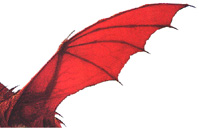
The wing. The part of the dragon that distinguishes itself from all other creatures. The dragon wing is a huge, leathery appendage that is found on several different species of dragon. The wing is usually larger than the dragon's body to accommodate the incredible force needed to lift and maintain flight.
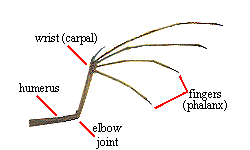
BONES
The wing is essentially another arm and hand. If you look at the skeleton of a dragon front arm and claws, you will notice that the wing is just a very stretched out version. The two thick "arm bones" (humerus and wing radius) runs from the body of the dragon attaching itself with cartilage and muscle to an "elbow" of the wing. There are usually 4 or 5 elongated "fingers" on a wing each ending in a claw. One short "thumb" claw is at the "wrist". The "fingers" then attach themselves to the "wrist joints" to form the complete wing.
HOW DO THEY FLY?
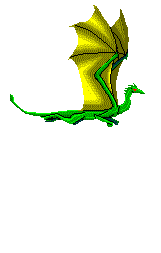
Thanks to Windseeker for the flying dragon animation
The actual force of flight is the continuous down sweep of powerful wings scooping, and thrusting the body upwards. An immature dragon does not have the strength needed for a vertical jump from flat ground to take off. They will usually stay near higher cliffs to use the heat updrafts to keep aloft. It takes a few years of flying to build the extremely strong flight muscles needed to lift the dragon body from the ground. The wings make actually look small for the mass of the dragon, but all dragons have an innate magic ability to help them fly. This magic helps keep dragons from straining themselves during long flights.
WEAPONS
Dragons can also use their wings as an attack weapon if need be, but this is a last resort. The wing membranes are easily damaged compared to the rest of a dragon body. If a dragon wing membrane is slashed, it takes a very long time to heal, and there is a chance the dragon might never fly again if it does not heal correctly. If attacked on the ground, the dragon will usually run then jump in the air and fly off avoiding the attacker. But if the dragon is trapped on the ground it will tuck its wings tightly against its body and use its breath weapon and claws to protect itself. If the dragon has to use its wings to attack it will scoop down and slash with its razor sharp wing claws to immobilize the attacker.
SENSES
Dragons have the same senses as humans; sight, hearing, smelling, touch, and taste. But some have a six sense which is being able to "read" the emotion of another being. Their regular five senses are incredibly sensitive. For example, the sense of smell is about 100 times more sensitive than a bloodhound dog. They can smell and hear a person or animal from a couple miles away!
Their six sense is very accurate at close range. If a person or animal is feeling a strong emotion, such as fear or hate, it will register very strongly to the dragon, even if it is not in visual range of it. This is where dragonfear comes from. Dragonfear is an all encompassing, frozen-in-place fear that the dragon causes upon the animal or person seeing a dragon. The dragons sometimes use this advantage to beat its foes, such as thieves or knights. Only the very bravest (or very dim-witted) are not affected by this terrible fear. This is usually an aura around evil-minded dragons, but in a friendly dragon, such as the Faerie Dragon, this aura is non-existant.
THE FIRE BREATHERS!
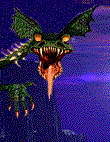
Fire: the thing that makes the dragon most feared. It's a hellish belch of flame that can turn flesh and bone into ash. Though, not all dragons breath fire. Some have freezing cold breath, others have acid, and some don't use their breath as a weapon at all! The two that have fire breathing power are the Red Dragon and Fire Drake.
HOW DO THEY BREATH FIRE?
It all starts when the dragon catch their prey. When dragons eat, they digest the food in a regular stomach. The digestion then continues in a second stomach that breaks down the food even further. After the dragon's body has used all it can from the second digestion, the body then turns the leftover food and acid into a byproduct of hydrogen. The dragon can hold the hydrogen in various large glands in it's body for later use, and can call upon it at any time it needs to. When the dragon needs to belch it's flame, the glands release the hydrogen into the lungs where it mixes with other various chemicals the body creates. Once this mixture finds oxygen, it burns extremely hot, and very quick. The dragon usually has enough hydrogen in its body for about three spits of flame, but that should be plenty for anything coming up against a large red dragon. This explanation is about the same for dragons that breath other types of breath. Their bodies just break down food into different compounds. For another explination of firebreathing, please read this explination by Firefenix.
CONCLUSION
I hope you enjoyed your little trip into the physiology of a dragon. Remember, all dragons are different, so if you dissagree with this study, no one can tell you that you are wrong. This is just one look at this wonderful creature and I hope that this might stir your imagination to make up your own mythology of the dragon.
Read some other explinations:
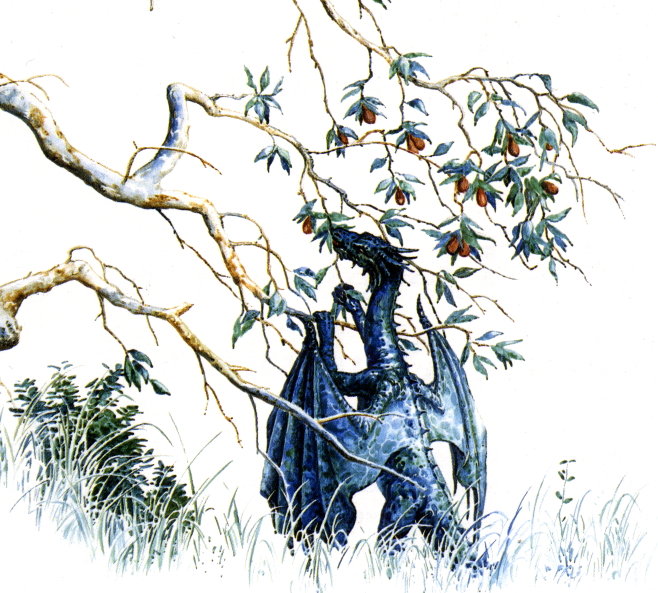
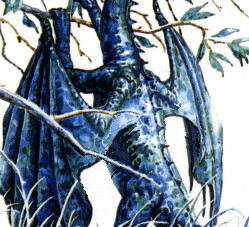 1. The wings are connected near the shoulder. This is the most improbable type of wing. The surface is small near the body making the flight and even the glidding difficult, moreover the rear of the dragon tends to "fall" toward the ground. However, this disposition gives good results if the dragon is hovering. | 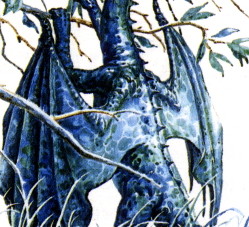 2. The wings are connected below the chest. The wings as shown on the complete picture above is somewhat the mix between the situation 1 and 3. There is no real mistake here, except that situation 3 is better. | 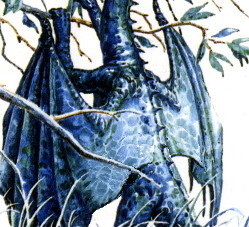 3. The wings are connected near the thighs. This give a greater surface for the wings than the situation 1 and 2. The long neck and the tail give balance and enable the dragons to quickly gain or lose altitude. This is definitively the most probable type of wings. |
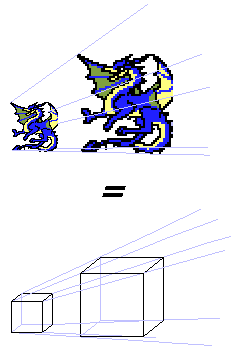 Dragons - David or Goliath?: This is more realistic to say that dragons are small creatures if you consider that they can fly otherwise, they will follow the same principle in the structures of these huge magnificient reptiles: the dinosaurs (in this case their wings would be absolutely useless). (Summary of the "Physic of Proportion": The rule is simple, when you change an object proportionally, the change "A" affect the dimension as this: the length=A, the Surface=A2 and the Volume=A3. Eventually I will fully detail the effect of this physics principle... until this time, please bear with this present section...) |
 Vertebrates (humans for example) | Composite eyes (insects for example) Each pixel is one of the several hundred lenses of the eye |
As shown on the picture above, for a creature with composite eyes, the Earth still look like the old planet we still know but the details are poor. For an insect, the important point is probably to distinguish the flowers from the landscape and your hand (or predator) before you hit him. It is simple and well, it does the work for them but seriously, any large creature would be greatly disadvantaged by this type of eyes. No slit at all; eyes appearing like a crystal ("crystalline" eyes)? 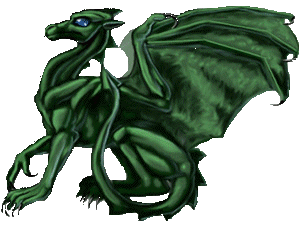 Glowing crystalline eyes? |
Classification and Evolution:
Note of the author: This section is still suject to discussion. Therefore, these informations are subject to change without notice. |
Art and Jewels
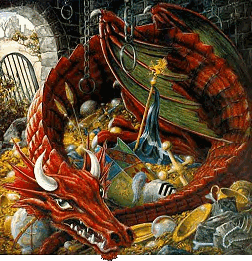
Subscribe to:
Comments (Atom)


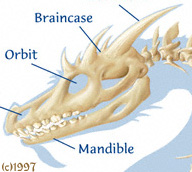
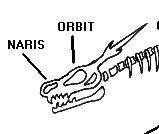
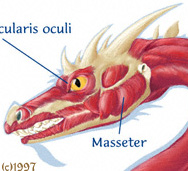
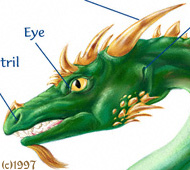
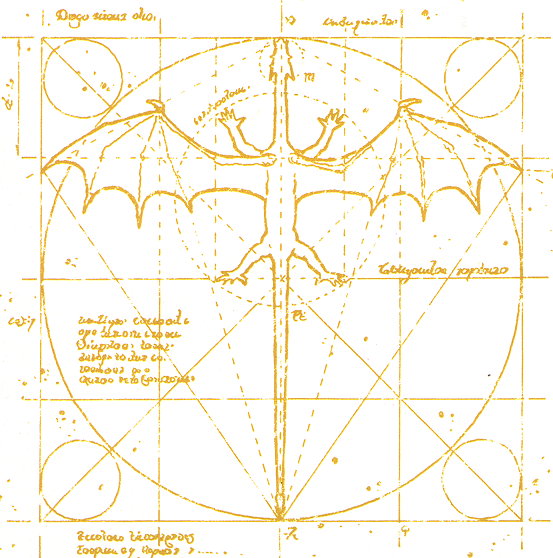
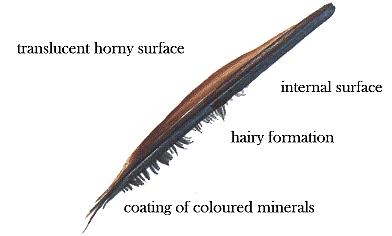
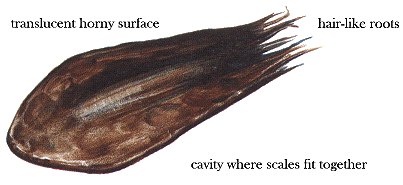
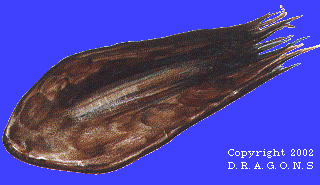
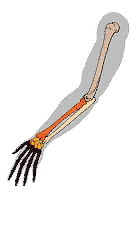
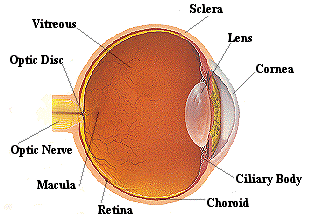
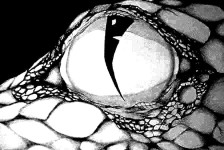
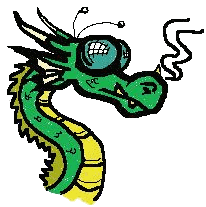
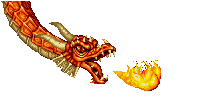 Fire Breather:
Fire Breather: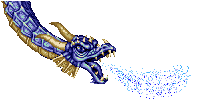 Cold/Frost Breather:
Cold/Frost Breather: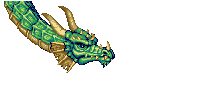 Acid Breather:
Acid Breather: